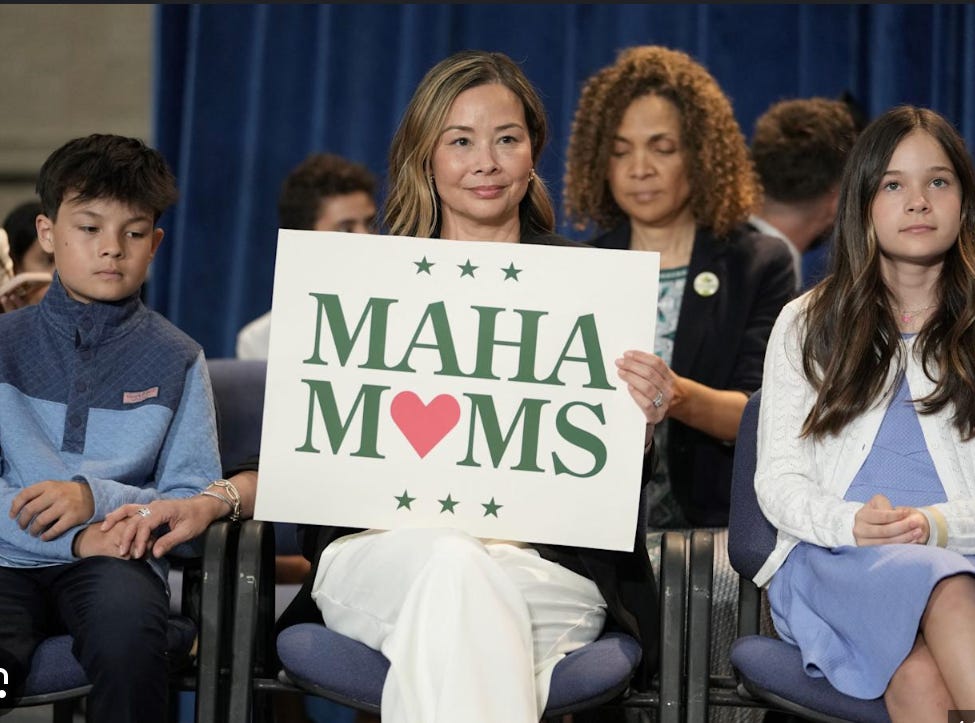in defense of MAHA moms
the skepticism is justified
This week, The New York Times published a piece on how the MAHA movement is reshaping modern motherhood. The article hinges on interviews with four mothers and two doctors, all seemingly concerned about MAHA’s growing influence among young moms.
True to form, the Times follows its usual health reporting formula: presume the absolute authority of the medical establishment and dismiss any deviation—especially regarding vaccines—as fringe, dangerous, or misinformed.
Their thesis? That the MAHA movement is veering into harmful territory, allegedly fueled by “fear” and “misinformation.”
In an attempt to show that vaccine-hesitant moms are ruled by emotion, the piece includes this gem of a quote:
“If you go to graveyards, there’s a lot of dead kids and they’re there because of measles and rubella,” Ms. Woods said (referring, she added, to infants who died long ago).
So wait—who’s actually operating on fear? The moms asking hard questions about vaccine safety? Or the ones invoking devastating stories from 1912?
Let’s be honest: the entire foundation of modern vaccine marketing is built on fear. Fear of disease, fear of death, fear of being labeled irresponsible. It’s a tactic used routinely. Not just by well-meaning pediatricians, but by vaccine manufacturers who profit from that fear.
So to claim that vaccine-hesitant moms are the ones being irrationally fearful? That’s not just wrong—it’s peak hypocrisy.
I know dozens of thoughtful, intelligent mothers who have either opted out of the standard vaccine schedule or chosen to delay. None of them arrived at that decision because of TikTok or Instagram fear-mongering. It was a decision made by swimming upstream, not flowing with the algorithm. They arrived there through research and discernment.
The real issue, it seems, is that many in the media and medical establishment can’t imagine an informed woman coming to a different conclusion than they’ve approved. So instead, they paint her as scared, naive, or manipulated. But increasingly, the opposite is true: it’s the “trust the science” crowd that is outsourcing their discernment to the headlines—and shaping their views based on fear, not facts.
Here’s what the MAHA moms do know:
The full CDC vaccine schedule—which includes up to 72 doses by age 18—has never been tested as a whole. There’s no long-term study evaluating the cumulative impact of this schedule on a child’s developing immune system, neurological health, or chronic disease risk.
America is an outlier. Our children receive more vaccines than any other Western country. Denmark, for example, recommends fewer than half the number of shots during childhood—and yet doesn’t face any sort of pediatric health crisis as a result.
Vaccine manufacturers are shielded from liability. Thanks to the 1986 National Childhood Vaccine Injury Act, pharmaceutical companies cannot be sued if a vaccine injures a child. Instead, parents must go through the Vaccine Injury Compensation Program, where the U.S. government—not the vaccine maker—pays damages. No other drug maker enjoys this kind of blanket legal immunity.
The ingredients would raise red flags anywhere else. Vaccines contain adjuvants and preservatives like aluminum and polysorbate 80—compounds that, in other contexts, are treated with caution due to their neurotoxic or permeability-enhancing properties.
The Hep B vaccine is a case in point. It’s designed to protect against a disease spread through blood or sexual contact. Yet it’s administered to newborns within 24 hours of birth, sometimes before the baby has even breastfed.
A 6-pound newborn receives 250 micrograms of aluminum in one dose—the same dose a 200-pound adult would get. There is no adjustment for size, organ maturity, or detox capacity.
Health authorities insist the aluminum is safe, citing formula-fed infants’ aluminum intake. But they ignore bioavailability: ingested aluminum is absorbed at around 0.3%, while injected aluminum is absorbed nearly 100%, bypassing the gut entirely and entering systemic circulation.
And Hep B is just the beginning. Over the first 6 months of life, babies can be exposed to 1,225–4,925 micrograms of aluminum from other vaccines like DTaP, Hib, and PCV.
I could go on for days about what MAHA moms know about health and science. When it comes to vaccines, we’ve barely scratched the surface.
I’m not sure whether the reporter is simply insulated from this reality, or if she’s actively choosing to ignore the legitimate concerns coming from America’s mothers.
Either way, it’s lazy journalism.
At the very least, she should’ve had the intellectual honesty to talk to a few knowledgeable MAHA moms directly. This would make a great story. Instead, she built her case around secondhand caricatures—arguing with a strawman, not real MAHA moms.
What’s fascinating is how much media oxygen MAHA moms are suddenly taking up. Journalists seem obsessed. Why? Not long ago, the gold standard of reporting was uncovering congressional insider trading or corporate environmental abuse. But now? The hottest exposés are about women drinking raw milk, delaying the Hep B shot, and rejecting microplastics.
Journalism has pivoted from follow the money to follow the mom on Instagram who gives her kids elderberry syrup.
And yet, the outsized attention says something. It reveals just how disruptive these women really are. They’re not storming institutions; they’re simply opting out. And somehow, that is enough to earn ink on the once-sacred pages of The New York Times.
This isn’t to say that the rise of MAHA moms shouldn’t be examined. It should. But instead of reducing them to conspiratorial cranks, why not dig deeper? Why not trace the movement’s origins and profile its rise to prominence? Why is the message of minimizing toxins and questioning medical orthodoxy resonating so deeply with modern mothers?
That’s the real story. And over the next few weeks, I’m planning to tell it.
Stay tuned.




👋 Proud but exhausted and overwhelmed MAHA mom here. We didn't ask for any of this nonsense. But here I am, the most unlikely activist/squeaky wheel/problem-causer ever, getting ready to have "the conversation" AGAIN with my kids' pediatrician tomorrow.
Always look forward to your posts. Thank you.